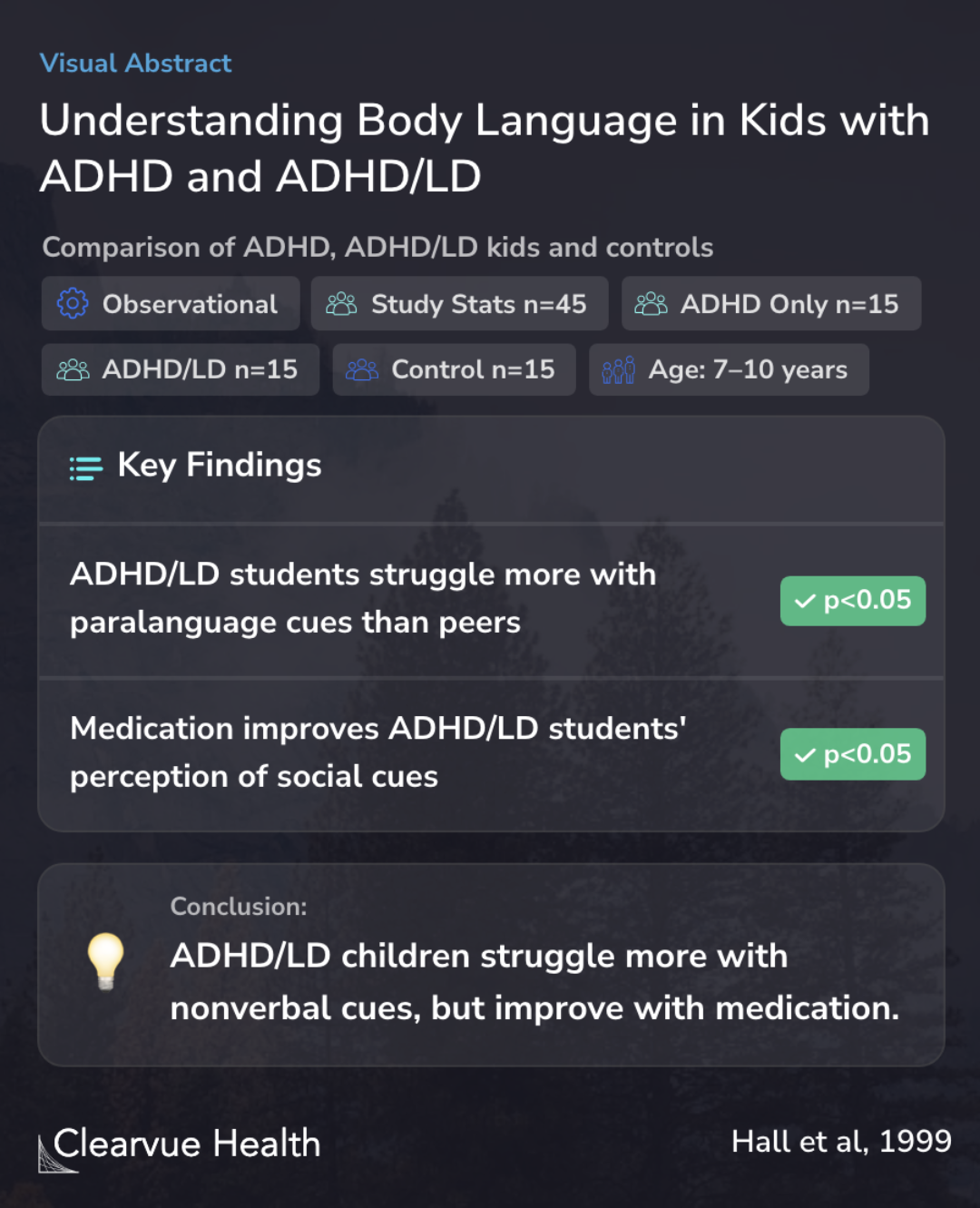Perception of nonverbal social cues by regular education, ADHD, and ADHD/LD students
Understanding Body Language in Kids with ADHD and ADHD/LD
Hall, C. W., Peterson, A. D., Webster, R. E., Bolen, L. M., Brown, M. B.

Objectives
The study set out to explore how well children diagnosed with ADHD, with and without learning disabilities, could understand nonverbal social signals, like facial expressions and body language, compared to kids without ADHD. Teachers also shared their observations on how these children grasped social cues.
Examined the ability of children diagnosed as having ADHD with and without a learning disability to perceive nonverbal social cues in comparison to their non-ADHD peers. In addition, teacher ratings of students' social perceptions were obtained.
Methods
The research involved 45 students aged 7 to 10. These children were divided into three groups: those with only ADHD, those with ADHD and a learning disability (ADHD/LD), and a control group with no diagnoses. The study used two main tools to assess social perception: the Diagnostic Analysis of Nonverbal Accuracy (DANVA) and the Social Perception Behavior Rating Scale (SPBRS). These assessments were conducted while the ADHD and ADHD/LD participants were medicated and again when they were not.
Participants in the study were 45 students between the ages 7–10 years who were identified as ADHD only, ADHD with a learning disability (ADHD/LD), and a control group with no diagnosis. The Diagnostic Analysis of Nonverbal Accuracy (DANVA) and the Social Perception Behavior Rating Scale...
Results
The study's findings showed that children in the ADHD/LD group had more difficulty understanding nonverbal cues like tone of voice and body posture compared to their peers. However, when these children were on medication, their ability to perceive these social cues improved significantly. This suggests that medication can play a role in enhancing social perception among children with ADHD, especially those with learning disabilities.
The ADHD/LD group demonstrated significant difficulty in comparison to their peers in perceiving paralanguage cues effectively. The ADHD/LD group also showed significant improvement on the Postures and Paralanguage subtests during on-medication conditions.
Conclusions
This research underscores the struggles that children with ADHD, particularly those with a learning disability, face in interpreting nonverbal social signals. It also highlights how medication can aid in improving these interpretive skills. These findings align with the broader context of research on ADHD and social impairment, further emphasizing the complexity of ADHD and the importance of tailored interventions.
The study highlights the challenges faced by children with ADHD, particularly those with a learning disability, in interpreting nonverbal social cues and the potential improvement in these skills with medication.
Key Takeaways
Context
In exploring the challenges faced by children with ADHD, particularly in social interactions, researchers have delved into a significant aspect: the role of language. The study by Staikova et al. in 2013 sheds light on this by examining how these children's difficulties in social settings might be linked to their language abilities. Specifically, it was found that children with ADHD often struggle with pragmatic aspects of language - the part of language that involves using words in social contexts. This means that even if their basic language skills are intact, when it comes to engaging in conversations and social interactions, they might find it hard to keep up.
In a related exploration, Redmond SM in 2004 expanded this understanding by comparing conversational profiles among children with ADHD, those with Specific Language Impairment (SLI), and those undergoing typical development. This comparison highlighted distinct speaking patterns, underscoring how ADHD and SLI can influence the way children communicate. These findings provide insights into the nuanced challenges faced by children with ADHD and also suggest that their social difficulties could, in part, be attributed to the way they use language in social situations.